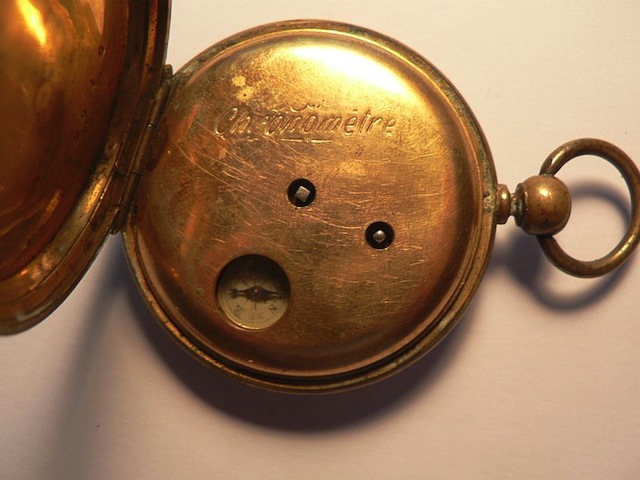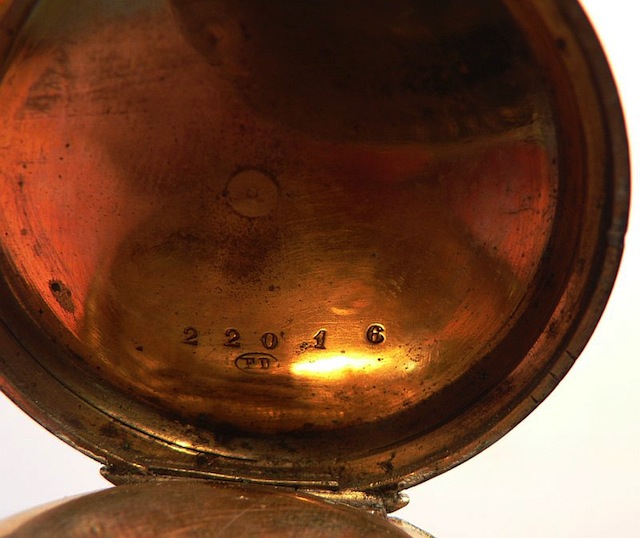
| WWT Shows | CLICK TO: Join and Support Internet Horology Club 185™ | IHC185™ Forums |

|
• Check Out Our... • • TWO Book Offer! • |
Welcome Aboard IHC185™  Internet Horology Club 185
Internet Horology Club 185  IHC185™ Discussion Site Main Page
IHC185™ Discussion Site Main Page  Horological Discussions, Questions and Answers
Horological Discussions, Questions and Answers  European Pocket Watch Forum
European Pocket Watch Forum  European pocket watch
European pocket watch
 Internet Horology Club 185
Internet Horology Club 185  IHC185™ Discussion Site Main Page
IHC185™ Discussion Site Main Page  Horological Discussions, Questions and Answers
Horological Discussions, Questions and Answers  European Pocket Watch Forum
European Pocket Watch Forum  European pocket watch
European pocket watchGo  | New Topic  | Find-Or-Search  | Notify  | Tools  | Reply to Post  |  |
I have my great-grandfather's pocket watch. He was born and raised in Denmark and emigrated to the US in the 1880's. His pocket watch was handed down to his son and to my father, and now to me. Our family jewler looked at it and said that it was very old and hand made. The regulator has an "A" and a "R" on it, indicating that it was made in Europe. The pocket watch has a compass inside and is a key wind and still in working order. It is a Chronometre watch and the number inside the case is #22046 with a "1" over the "4". Does anyone know anything about this pocket watch? | |||
|
A picture would be worth 10,000 words. So far, your description could fit a myriad of possibilities. Dave Turner | ||||
|
Dave, I took four pictues of the watch, but they are too large to post here. If you e-mail me, I can send them to you as an attachment. Pat | ||||
|
email sent. I'll try to help. Dave Turner | ||||
|
watch mvmt: Dave Turner  | ||||
|
Euro dial: Dave Turner  | ||||
|
case with compass: Dave Turner  | ||||
|
case back: Dave Turner  | ||||
|
| IHC Life Member |
Pat, you should treasure the watch as a family memento, but that I don't think it is valuable in other respects. It appears to be an very ordinary key wind Swiss watch watch, with perhaps seven jewels, maybe less. I can't tell from the photographs, but it likely has a cylinder escapement, very common in lower grade Swiss movements, but difficult to repair and obsolete before the end of the 19th Century. The case appears to be brass. Neither it nor the dial are in great shape. The hands don't match. I don't doubt that a lot of handwork went into the watch, but that's the way the Swiss made watches back then. The only unusual features I see in the watch are the compass, which is a bit of a novelty, and the "skeleton" work on the upper plate. When the watch was made, that upper plate almost certainly was a solid piece of metal. Long ago, likely after the watch was sold, someone decorated the watch by cutting away parts of the upper plate and engraving it to create the fanciful design it now has. One doesn't see this very often, but I doubt it adds material value to the watch. As I said at the outset, you should treasure the watch as a link to your great grandfather, but you wouldn't be able to add much to your bank account if you sold it. | |||
|
Ethan, thank you so much for your valuable in-put regarding the pocket watch. Being a complete novice when it comes to "watch" terms, I have a few questions. You said it had perhaps seven jewels. What does that mean? What is a cylinder escapment? When you refer to the skeleton work on the upper plate, which part of the watch is that? As you can see, I really am a novice! Since it is made of brass, am I safe to clean it up myself or should I have a jeweler do that work? Now I know that it is a Swiss watch. Thank you so much for your information regarding this family treasure...as it has been part of us for over 100 years. Pat | ||||
|
| IHC Member 1016 |
Patricia, thanks for showing this watch here on IHC 185. This is one of our "perks" to be able to see unusual watches and read people's stories. I concur with Ethan and he is certainly knowledgeable. As to your specific questions Ethan, or Dave, will probably answer better than I could. Again, thanks for sharing your family heirloom. | |||
|
| IHC Life Member |
Pat. you asked what I meant by my references to a cylinder escapement and 7 jewels. Watches are powered by a mainspring, which on you watch is wound by a key. Without an "escapement," a wound watch would quickly unwind, with its hands twirling around the dial as in a cartoon. An escapement is a device that only permits the mainspring to unwind in carefully measured beats, which the hands reflect as the passage of time. All mechanical watches have escapement. Their design evolved over the centuries. Cylinder escapements are one of the more recent designs. In the early 1800s, high-end watches were made with them, but cylinder escapements were superseded by lever escapements over the course of that century, ultimately only being used in cheap watches, and ceasing to be used before WWII. It would take considerable effort to explain how cylinder escapements work. If you are interested, search for an explanation on the Internet. As for jewels, mechanical watches have gears and wheels that run on "axles" with bearings at each end. To protect the axles and bearing from wear, jewels (of no value) are placed at each end of the axle and other wear points. 17 jewels are needed to fully jewel a watch, although some watches had more and many had less. Starting in the second half of the 1800s, virtually all higher end watches had more than 7 jewels. As for polishing the case, I recommend against that. It will destroy a century of patina. Finally, the "skeleton" work is the decorative piercing/engraving on the plate through which the winding and setting posts are accessed. | |||
|
Ethan, You have provided me with such a wealth of information regarding my great-grandfather's pocket watch. I have copied and saved everything that you have shared about it and will keep it with the watch. That way, when I pass it on to the next generation, they will have a wonderful knowledge of their ancestor's pocket watch. I just have one more question. If you had to take a guess as to the age of the watch, where would you place it yearwise? Thank you Ethan. I really appreciate all the time that you have taken to educate me and I was lucky enough to have known my great Danish grandparents. They died when I was five. Pat | ||||
|
| IHC Life Member |
Though just a guess, I think the watch was made between 1860 and 1885. | |||
|
| Administrative Assistant |
Hello Patricia, As Ethan suggested, I did a google search using the words "cylinder escapement in motion" and found this animation… Click for: cylinder escapement in motion …hope this helps, Debbie | |||
|
Debbie, Thank you so much! That animation really helped me to understand what a cylinder escapement is all about. Pat | ||||
|
| Administrative Assistant |
Pat, You are welcome - glad it helped! Debbie | |||
|
| Powered by Social Strata |
| Your request is being processed... |
|
©2002-2025 Internet Horology Club 185™ - Lindell V. Riddle President - All Rights Reserved Worldwide

